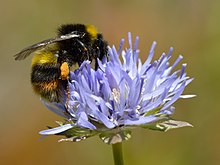Thistle bumblebee
| Thistle bumblebee | ||||||||||||
|---|---|---|---|---|---|---|---|---|---|---|---|---|

Thistle bumblebee ( Bombus soroeensis ) |
||||||||||||
| Systematics | ||||||||||||
|
||||||||||||
| Scientific name | ||||||||||||
| Bombus soroeensis | ||||||||||||
| ( Fabricius , 1777) |
The thistle bumblebee ( Bombus soroeensis ) is a species from the genus of the bumblebees ( Bombus ). In Germany it is shown in the Red List of Threatened Species as "critically endangered" (Category 2).
features
The animals reach a body length of 15 to 17 mm (queen), 10 to 14 mm (worker) or 12 to 14 mm (drone). Their wingspan is 28 to 33 mm (queen), approx. 23 mm (worker) and 25 to 28 mm (drone). The body of the animals is almost completely black, only at the end of the abdomen it has orange-red hair from the rear half of the fourth tergite and thus looks very similar to the stone bumblebee ( Bombus lapidarius ). It differs from this by a slight indentation instead of a clear notch in the upper lip ( labrum ). The stone bumblebee also has a bald spot on the upper side of the last abdomen segment. The hairiness of the thorax is unevenly long, but shorter than in the similar species. Occasionally one can observe individuals with a yellowish collar on the thorax and it also happens that the black color has a brown tinge. In Central Europe, in addition to the thistle bumblebees described above, there are also completely black and those with black, red and white colored abdomen. Black, yellow and white colored animals can be found in the Pyrenees and the British Isles . Their head is short, as is the proboscis, and reaches a length of 13 to 14 mm (queen), 10 to 13 mm (worker) or 9 to 11 mm (drone). One can confuse the species with the queens of the meadow bumblebee ( Bombus pratorum ).
Occurrence
The species inhabits moors and heaths in the lowlands , otherwise it is found in mountain locations from 1100 to 2600 meters, especially in forests and bushes. The species is rare everywhere, it is almost non-existent in northern Germany. Queens can be seen looking for suitable nesting sites from late April to late May, workers appear from mid-May to late September. Young queens and drones fly from mid-August to late September.
Way of life
The thistle bumblebee forms underground nests, in abandoned nests of small mammals, with up to 80 to 150 individuals. The species is counted among the pollen stormers; This means that in addition to the nectar, pollen is also stored in disused brood cells. The most important food plants include dead nettles , bearded bluebells , black nettles , motherwort , meadow clover , white clover , vetches , great boarwort , blue monkshood and pigeon clover . Queen and worker fly almost exclusively hopping from blade to blade. The queen produces a deep hum.
literature
- Eberhard von Hagen, Ambros Aichhorn: Bumblebees. determine, settle, multiply, protect. Fauna Verlag, Nottuln 2003, ISBN 3-935980-28-0 .
Web links
Individual evidence
- ↑ a b c d Eberhard von Hagen: Hummeln. determine, settle, multiply, protect. Naturbuch Verlag, Augsburg 1994, ISBN 3-89440-041-2 , p. 218 f.

